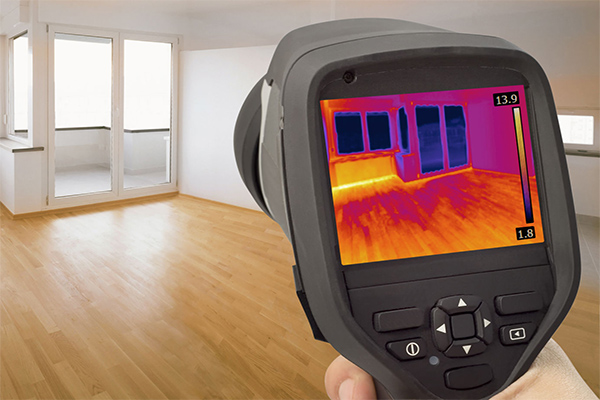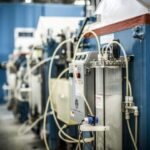Introduction
Thermal Infrared Testing is also known as(AKA Thermal Inspection, Thermography, Thermal Imaging, Thermal Wave Imaging and Infrared Testing)

(Photo courtesy of NASA/JPL-Caltech/IPAC)
Thermal NDT methods involve the measurement or mapping of surface temperatures as heat flows to, from and/or through an object. The simplest thermal measurements involve making point measurements with a thermocouple. This type of measurement might be useful in locating hot spots, such as a bearing that is wearing out and starting to heat up due to an increase in friction.
In its more advanced form, the use of thermal imaging systems allow thermal information to be very rapidly collected over a wide area and in a non-contact mode. Thermal imaging systems are instruments that create pictures of heat flow rather than of light. Thermal imaging is a fast, cost effective way to perform detailed thermal analysis. The image above is a heat map of the space shuttle as it lands.
Thermal measurement methods have a wide range of uses. They are used by the police and military for night vision, surveillance, and navigation aid; by firemen and emergency rescue personnel for fire assessment, and for search and rescue; by the medical profession as a diagnostic tool; and by industry for energy audits, preventative maintenance, processes control and nondestructive testing. The basic premise of thermographic NDT is that the flow of heat from the surface of a solid is affected by internal flaws such as disbonds, voids or inclusions. The use of thermal imaging systems for industrial NDT applications will be the focus of this material.
History of Thermal Testing
The detection of thermal energy is not a problem for the human body. Some sources say that the nerve endings in human skin respond to temperature changes as small as 0.009oC (0.0162oF). While humans have always had the ability to detect thermal energy, they have not had a way to quantify temperature until a few hundred years ago. A few of the more significant thermal measurement advances are discussed in the following paragraphs.
The Thermometer

Ancient Greeks knew that air was expanded by heat. This knowledge was eventually used to develop the thermoscope, which traps air in a bulb so that the size of the bulb changes as the air expands or contracts in response to a temperature increase or decrease. The image on the right shows the first published sketch of a thermoscope, which was published by Italian inventor Santorio Santorii. The next step in making a thermometer was to apply a scale to measure the expansion and relate this to heat. Some references say that Galileo Galilei invented a rudimentary water thermometer in 1593 but there is no surviving documentation to support his work on this. Therefore, Santorii is regarded as the inventor of the thermometer, for he published the earliest account of it in 1612. Gabriel Fahrenheit invented the first mercury thermometer in 1714.
Infrared Energy
Sir William Herschel, an astronomer, is credited with the discovery of infrared energy in 1800. Knowing that sunlight was made up of all the colors of the spectrum, Herschel wanted to explore the colors and their relationship to heat. He devised an experiment using a prism to spread the light into the color spectrum and thermometers with blackened bulbs to measure the temperatures of the different colors. Herschel observed an increase in temperature from violet to red and observed that the hottest temperature was actually beyond red light. Herschel termed the radiation causing the heating beyond the visible red range “calorific rays.” Today, it is called “infrared” energy.
The Seebeck Effect (Thermocouples)

In 1821, Thomas Johann Seebeck found that a circuit made from two dissimilar metals, with junctions at different temperatures, would deflect a compass needle. He initially believed this was due to magnetism induced by a temperature difference, but soon realized that it was an electrical current that was induced. More specifically, the temperature difference produces an electric potential (voltage) which can drive electric current in a closed circuit. Today, this is known as the Seebeck effect.
The voltage difference, DV, produced across the terminals of an open circuit made from a pair of dissimilar metals, A and B, whose two junctions are held at different temperatures, is directly proportional to the difference between the hot and cold junction temperatures, Th– Tc. The Seebeck voltage does not depend on the distribution of temperature along the metals between the junctions. This is the physical basis for a thermocouple, which was invented by Nobili in 1829.
Noncontact Thermal Detectors
Melloni soon used the thermocouple technology to produce a device called the thermopile. A thermopile is made of thermocouple junction pairs connected electrically in series. The absorption of thermal radiation by one of the thermocouple junctions, called the active junction, increases its temperature. The differential temperature between the active junction and a reference junction kept at a fixed temperature produces an electromotive force directly proportional to the differential temperature created. This effect is called a thermoelectric effect. Melloni was able to show that a person 30 feet away could be detected by focusing his or her thermal energy on the thermopile. Thermopile detectors are used today for spectrometers, process temperature monitoring, fire and flame detection, presence monitor, and a number of other noncontact temperature measurement devices. A device similar to the thermopile measured a change in electrical resistance rather than a voltage change. This device was named the bolometer, and in 1880 it was shown that it could detect a cow over 1000 feet away.
During World War I, Case became the first to experiment with photoconducting detectors. These thallium sulfide detectors produced signals due to the direct interaction of infrared photons and were faster and much more sensitive than other thermal detectors that functioned from being heated. During World War II, photoconductive or quantum detectors were further refined and this resulted in a number of military applications, such as target locating, tracking, weapons guiding and intelligence gathering.
Imaging Systems
Application areas expanded to surveillance and intrusion during the Vietnam era. Shortly thereafter space-based applications for natural resource and pollution monitoring and astronomy were developed. IR imaging technology developed for the military spilled over into commercial markets in the 1960s. Initial applications were in laboratory level R&D, preventative maintenance applications, and surveillance. The first portable systems suitable for NDT applications were produced in the 1970s. These systems utilized a cooled scanned detector and the image quality was poor by today’s standards. However, infrared imaging systems were soon being widely used for a variety of industrial and medical applications.
In the late 1980s, the US military released the focal plane array (FPA) technology into the commercial marketplace. The FPA uses a large array of tiny IR sensitive semiconductor detectors, similar to those used in charge couple device (CCD) cameras. This resulted in a dramatic increase in image quality. Concurrently, the advances in computer technology and image processing programs helped to simplify data collection and to improve data interpretation.
Current State
In 1992, the American Society for Nondestructive Testing officially adopted infrared testing as a standard test method. Today, a wide variety of thermal measurement equipment is commercially available and the technology is heavily used by industry. Researchers continue to improve systems and explore new applications.


